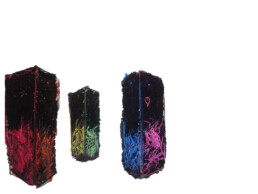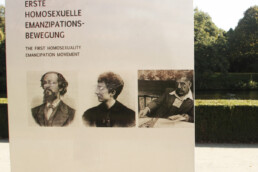Material: GRP (glass reinforced plastic), iron, powder coating; height 420 cm, diameter ca. 6 cm
Despite its name, the Calla Lily is neither a Calla nor a Lily. The plant’s ambiguous botanical identity and the controversy surrounding its categorization symbolize the departure from a binary gender model and encourage reflection on sexual diversity and non-conforming gender identities. The sculpture for public space is inspired by Magnus Hirschfeld’s research on human sexuality, particularly his theses on hermaphroditism (now intersex and transgender) – the design’s aesthetics evoke associations with both male and female interpreted sexual organs. The oversized, rainbow-colored blossoms of the monument at Magnus-Hirschfeld-Ufer in Berlin connect in color to an internationally recognized symbol of the LGBTQI* community and commemorate the first homosexual emancipation movement. The developmental stages from bud to fully bloomed Lily correspond to the various stages of sexual emancipation worldwide.
To the website of the Memorial to the First Homosexual Emancipation Movement
Design by Hirschfeld AG, consisting of:
Sajana Joshi
Malvina Panagiotidi
Jonathan Ryall
Martin Binder
Raju G.C.
Xue Wang
Igor Sovilj
Ino Varvariti
Giannis Delagrammatikas
Alternative Concept:
Scratching – a monument as a process
Materials: Stainless steel, color coating in six colors, covered with black paint
Dimensions: 6 steles, 225 cm x 300 cm x 10 cm
Concept: By scratching the black sacrificial layer with hard objects such as keys or coins, visitors can leave scratch marks and scratch the colors under the black layer. In this way, the risk of vandalism for a monument of this type is constructively transformed, with traces of memory and scratching movements exposing the rainbow colors. The scratching activity is a reference to the repeated damage to the existing memorial plaques on Magnus Hirschfeld Ufer.
The vandalism includes deforming a plaque, smearing writing and symbols on the front and back and scratching out the eyes of the personalities depicted on the plaques. This form of productive interaction of destruction is reminiscent of the deliberate destruction of the library of the Institute for Sexual Science by Berlin National Socialists in May 1933 (around 20,000 books, 35,000 photographs and 40,000 field reports as well as biographical letters were burned). Other examples of homophobic vandalism in public spaces include the damage to the memorial to homosexuals persecuted under National Socialism in Tiergarten, the damage to the memorial plaque at Nollendorfplatz subway station for homosexuals persecuted under National Socialism and the repeated burning of a rainbow sculpture. The repeated vandalism of the Hirschfeld memorial plaques becomes a design element of the memorial. The collective scratching activity of the visitors depicts a lively movement that leaves traces of cohesion and makes solidarity with the first homosexual emancipation movement visible through the exposed colors. Similar to the appropriation of discriminatory terms by the homosexual communities and the resulting stigma reversal of the terms “gay”, “homo”, “queer” or “gay”, this memorial design uses appropriation as a strategy for reversing vandalism.
The symbolic undermining of destruction turns scratching into a positive, productive act. The increasing prominence of the lower colors increases the visibility of the monument. By scratching off the paint, the monument changes and offers a place in public space that makes liberation and emancipation visible. The more paint is scratched off, the more multicolored the monument becomes and the more clearly the six colors stand out under the black of the metal wall. This action strategy calls for active participation, which is possible for people of any height and can be done spontaneously with objects brought along as scratching tools. The height of the monument prevents the black color from disappearing completely and thus also reminds us that not all goals of homosexual emancipation have been achieved for a long time. The scratch marks left by passers-by contribute to a living memorial.


